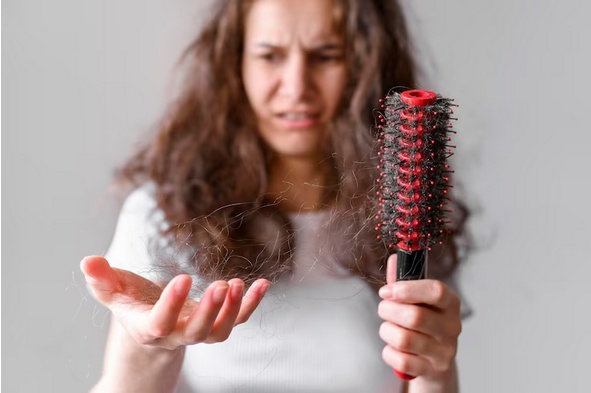Introduction:
Hair loss is a common and often distressing condition that affects individuals of all ages and genders. While it can be caused by various factors, the emotional impact of losing one's hair can be significant. In this comprehensive guide, we will explore the causes of hair loss, the emotional toll it can take, and the journey of restoration, including available treatments and lifestyle changes. Understanding the complexities of hair loss is the first step in navigating the path toward effective restoration.
Understanding Hair Loss:
Hair loss, or alopecia, can manifest in different forms, including gradual thinning, bald patches, or complete baldness. Various factors contribute to hair loss, and these can be broadly categorized into genetic, hormonal, environmental, and lifestyle factors.
-
Genetic Factors: Male-pattern baldness and female-pattern baldness are often genetically determined. These conditions, known as androgenetic alopecia, result in a gradual reduction of hair follicles, leading to thinning and eventual hair loss.
-
Hormonal Changes: Hormonal fluctuations, such as those that occur during pregnancy, childbirth, menopause, and conditions like polycystic ovary syndrome (PCOS) in women, can contribute to hair loss. In men, an excess of dihydrotestosterone (DHT), a hormone derived from testosterone, is a common cause of male-pattern baldness.
-
Environmental Factors: Exposure to environmental stressors, such as pollution, harsh chemicals, and excessive heat styling, can damage hair and contribute to hair loss. Additionally, certain medical treatments like chemotherapy can result in temporary or permanent hair loss.
-
Lifestyle Factors: Poor nutrition, high stress levels, lack of sleep, and an unhealthy lifestyle can impact the health of hair follicles, leading to increased hair shedding and thinning.
The Emotional Toll of Hair Loss:
Hair loss often goes beyond physical changes, taking a considerable emotional toll on individuals. The psychological impact can include feelings of self-consciousness, reduced self-esteem, and even anxiety or depression. Society's beauty standards and the perception of a full head of hair as a symbol of youth and vitality can exacerbate the emotional challenges associated with hair loss.
Navigating the Journey of Restoration:
The journey toward hair restoration involves a combination of understanding the underlying causes, seeking appropriate treatments, and making lifestyle changes. Here are key aspects to consider when navigating the path of hair restoration:
-
Professional Consultation: The first step in addressing hair loss is consulting with a healthcare professional or a qualified dermatologist. A thorough examination and discussion of medical history can help identify the root cause of the hair loss and determine the most suitable treatment plan.
-
Available Treatments: There are various treatments available for hair loss, ranging from topical solutions and oral medications to advanced procedures. Minoxidil and finasteride are common medications that have shown effectiveness in promoting hair growth. Additionally, treatments like platelet-rich plasma (PRP) therapy, low-level laser therapy (LLLT), and hair transplantation are advanced options for those seeking more comprehensive restoration.
-
Topical Solutions: Over-the-counter and prescription topical solutions, such as minoxidil, can be applied directly to the scalp to stimulate hair follicles and promote regrowth. These solutions are often easy to incorporate into daily routines.
-
Oral Medications: Finasteride, an oral medication, works by inhibiting the hormone DHT, which is responsible for shrinking hair follicles. It is essential to consult with a healthcare professional before starting any oral medication to assess suitability and potential side effects.
-
Advanced Procedures: Advanced procedures, including PRP therapy and LLLT, harness the power of the body's natural processes to stimulate hair growth. PRP involves extracting the patient's blood, processing it to concentrate platelets, and injecting it into the scalp to promote hair follicle activity. LLLT devices use low-level lasers or LEDs to stimulate hair follicles.
-
Hair Transplantation: For those seeking a more permanent solution, hair transplantation involves transplanting hair follicles from one part of the body (usually the back of the scalp) to areas experiencing hair loss. This surgical procedure provides a natural-looking and long-lasting result.
Lifestyle Changes for Hair Health:
In addition to professional treatments, making certain lifestyle changes can contribute to maintaining healthy hair and supporting the success of restoration efforts:
-
Balanced Nutrition: A diet rich in vitamins, minerals, and proteins is essential for overall health, including the health of hair follicles. Foods such as leafy greens, fish, nuts, and lean proteins contribute to the strength and vitality of hair.
-
Stress Management: Chronic stress can contribute to hair loss, so incorporating stress-management techniques such as meditation, yoga, and regular exercise is crucial for overall well-being.
-
Scalp Care: Adopting a gentle hair care routine, including regular washing with a mild shampoo, avoiding excessive heat styling, and protecting the scalp from sun exposure, can contribute to optimal scalp health.
Conclusion:
The journey of hair loss and restoration is a personal and multifaceted experience that involves understanding the causes, seeking professional guidance, and making informed choices. Advances in medical treatments and technology provide individuals with a range of options to address hair loss and regain confidence.
The emotional toll of hair loss is significant, but by navigating the journey of restoration, individuals can take proactive steps toward regaining a fuller head of hair and a positive self-image. Whether opting for topical solutions, oral medications, advanced therapies, or surgical procedures, the benefits of successful hair restoration extend beyond physical appearance, encompassing improved self-esteem and overall well-being.
In conclusion, tress troubles can be effectively addressed through a combination of professional guidance, available treatments, and lifestyle changes. By taking charge of the journey of hair restoration, individuals can move toward a future with a healthier, fuller head of hair and renewed confidence.


No comments yet